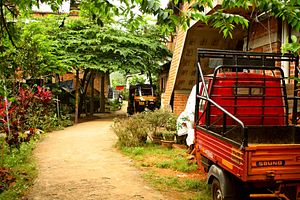Any intervention that transform people’s lives for the better is a story worth hearing. This is particularly true if the tale has something new to offer – something similar projects could replicate. Karimadom colony, situated in the heart of Thiruvananthapuram, the capital city of the south Indian state of Kerala, is a proud and fitting example of how a slum can and should be transformed. The colony, which was until 2009 in a wretched condition owing to poor housing and drainage, leading to waterlogged dwellings during monsoons, is being transformed into an eco-friendly, hygienic, and dignified abode.
Problems were aplenty before 2009. The colony was situated on a piece of land that was 60 cm below the road surface level. This meant that whenever the nearby sewage-collection pond overflowed, its water would rush into the colony and its houses. During monsoons, the colony would flood, forcing its residents to move into temporary shelters nearby. While these were not daily issues, the open drain that ran through the middle of the colony was. Apart from infrastructural issues, the colony was also plagued by a strong marijuana racket that operated from within it.
The colony was selected under the Jawaharlal Nehru National Urban Renewal Mission (JNNURM) and its sub-mission Basic Services for the Urban Poor (BSUP), for upgrading and redevelopment. One hundred and forty of the total 560 households in the colony have already moved into the upgraded houses; construction of the remainder is underway.
If you were to ponder the reasons for the success of the project, you could do worse than start with the socio-political nature of Kerala. Govindan Parayil and T.T. Sreekumar note that the state has a history of anti-caste struggle supported by all major political parties dating back to the 1930s. Kerala was able to successfully implement land reforms, uprooting landlordism and quashing tenancies as early as the late 1950s. Since then, it has enjoyed “consensus politics” on development policy, notwithstanding major ideological differences among political parties. Celebrated economists Amartya Sen and Jean Dreze observe that this history has given the state a unique characteristic in which public action and popular demand reinforce one another, a state of affairs not often seen in India. The literate and politically active population is not hesitant to put forward its demands and the political apparatus has a history of listening to them.
Second, the approach adopted by the Centre of Science and Technology for Rural Development (COSTFORD), the implementing agency of the project, has been instrumental. Architect P.B. Sajan, joint director of COSTFORD, asserts that any slum upgrade should not be seen merely as a rehabilitation project, but as an exercise in transformation. He adds that people need comprehensive, life-changing solutions that suit their environment, not just better houses. The houses which COSTFORD has been building at Karimadom employ alternate building techniques that make use of materials in their natural form, without altering their texture or color. COSTFORD believes that indigenous architecture and local building materials should be preferred, because they are best suited to the local conditions. Such practices are cost and energy efficient too.
Third, the women in the colony played an active role in the transformation. They have shown the courage to come out of the domain of the individual to form collectives seeking major changes in their lives. Local women mobilized the residents against the dominant drug racket for which the colony was infamous. As a result, today, the racket has almost disappeared. Vanita Suraksha Samiti (Women Safety Committee) and Kudumbashree (an institution of self-help groups) have been dynamic players in the colony. The latter joined hands with COSTFORD and the local urban government to assist in every step of the slum transformation: from creating a list of beneficiaries to resolving disputes concerning the same.
Not everything is good and green at Karimadom. Waste management remains unattended. The colony does not have an in-house mechanism to treat solid waste. The city municipal corporation currently collects waste from the colony and dumps it elsewhere. This implies that the colony is a net contributor to the city’s garbage dump, which is not environmentally sustainable. The large pond within the colony premises, which collects sewage from parts of the city, is a serious health threat. The Detailed Project Report talks about a system for waste management and initiatives to clean the pond, but these have yet to be implemented.
A lot has been done and more remains. The transformation of Karimadom colony may not be a perfect and comprehensive model for other projects to follow – at least not yet. Nevertheless, this transformation story offers worthwhile insights into factors that might contribute to the success of a similar project. This is especially beneficial in an age when time and resources are more valuable than ever, and “what works” is a prized piece of information.
Alen John is a Junior Research Fellow with the Andhra Pradesh State Development Planning Society, Planning Department, Government of Andhra Pradesh, India. Views expressed are personal.
































